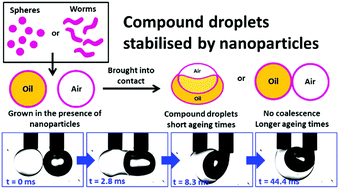Effect of morphology on interactions between nanoparticle-stabilised air bubbles and oil droplets†
Abstract
High-speed video analysis has enabled the interaction between a pair of millimetre-sized air bubbles to be studied in aqueous solution. The bubbles were grown in the presence of either poly(glycerol monomethacrylate)–poly(benzyl methacrylate) (PGMA–PBzMA) diblock copolymer spheres or poly(glycerol monomethacrylate)–poly(2-hydroxypropyl methacrylate)–poly(benzyl methacrylate) (PGMA–PHPMA–PBzMA) triblock copolymer worms prepared by polymerisation-induced self-assembly (PISA). A reduction in interfacial tension relative to air bubbles grown in the absence of nanoparticles indicated the adsorption of nanoparticles at the air–water interface. A concentration of 0.01% w/v PGMA–PBzMA spheres conferred air bubble stability after just 30 s interfacial ageing with stirring, whereas 300 s ageing was required for worms to prevent coalescence at the same copolymer concentration. However, longer coalescence times with interfacial age suggested greater worm adsorption on the air bubbles during this period. In striking contrast, although stable millimetre-sized n-dodecane droplets were obtained in the presence of 0.01% w/v copolymer worms, the copolymer spheres did not prevent coalescence at this low concentration. Finally, the multiphase interaction and stability of immiscible fluids in the presence of either spheres or worms was assessed. More specifically, an n-dodecane oil droplet and an air bubble were grown separately in the presence of either the spheres or worms and then brought into contact. In the absence of any nanoparticles, aqueous film drainage resulted in the formation of a compound droplet consisting of an air lens on the oil droplet. In the presence of 0.01% w/v nanoparticles, ageing times of either 30 s or 120 s were required to prevent formation of compound droplets when using spheres and worms, respectively. Moreover, this asymmetric system required much shorter ageing times in the presence of adsorbed nanoparticles to gain stability compared to either the symmetric air bubble or oil droplet systems. This stability is attributed to a bridging nanoparticle monolayer between the oil droplet and the air bubble.



 Please wait while we load your content...
Please wait while we load your content...